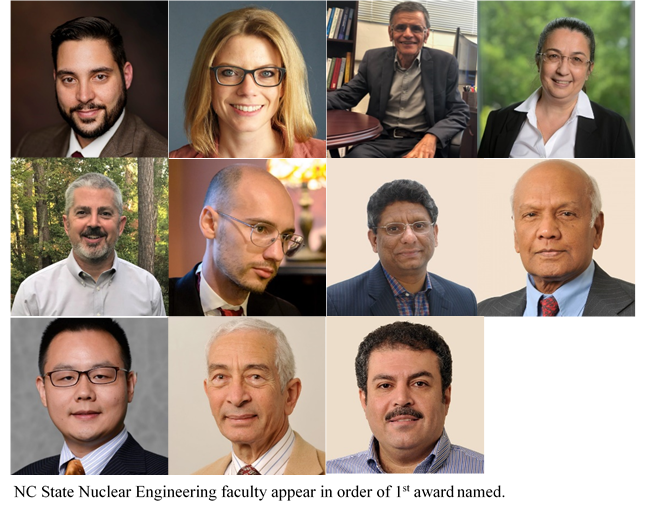Congratulations to NC State Nuclear Engineering faculty, recipients of five research & development ($2.4 million), two infrastructure ($631 k) and one nuclear science user facilities ($500 k) awards from the U.S. Department of Energy (DOE). Faculty members continue to contribute to the direction and scope of nuclear engineering work and educating the next generation. The eight projects include,
Under Fuel Cycle Research and Development –
Plasma-Bubble Spectroscopy: A Method for Real-Time Material Quantification in Molten Salts
Principal Investigator (PI): Alexander Bataller (NC State University)
Co-PI: Katharina Stapelmann (NC State University)
Collaborators: Ammon Williams (INL)
The overarching objective of the proposed research is to investigate a new method for quantifying nuclear materials in molten salts using a technique we call “plasma-bubble spectroscopy”. The proposed technique addresses several critical challenges facing materials accounting in molten salts, which include online monitoring capability, shot-to-shot stability, optical clarity, and the possibility of uranium isotopic quantification.
Under Nuclear Energy –
Integral Benchmark Evaluation of Zero-Power Tests and Multi-Cycle Depletion Experimental Data of TVA WB1 Cycles 1-3
PI: Kostadin Ivanov (NC State University)
Collaborators: Maria Avramova & Scott Palmtag (NC State University), G. Singh (INL), N. Martin (INL), F. Franceschini (Westinghouse Mangiarotti)
This project proposes to develop an integral benchmark evaluation of available experimental data for zero-power tests and multi-cycle depletion for consistent and comprehensive validation of both novel high-fidelity and traditional multi-physics tools. The benchmark evaluation will be based on operational and measured data from the Pressurized Water Reactor Watts Bar Unit 1 released by Tennessee Valley Authority.
Under Reactor Concepts Research & Development and Demonstration (RCRD&D) –
PI: Mihai A. Diaconeasa (NC State University)
Collaborators: Abhinav Gupta (NC State University), Jordan T. Boyce (INL), Stephen Ted Wood (INL)
The main objective of the proposed work is to develop, demonstrate, and evaluate a probabilistic risk assessment (PRA) software platform needed to address the major challenges of the current legacy PRA tools. This includes better quantification speed, integration of multi-hazard models into traditional PRAs, and model modification/ simplification and documentation automation.
Quantifying the Dynamic and Static Porosity/Microstructure Characteristics of Irradiated Graphite through Multi-technique Experiments and Mesoscale Modeling
PI: Jacob Eapen (NC State University)
Collaborators: Korukonda Murty (NC State University); Rick Ubic (Boise State University), Karthik Chinnathambi (Boise State University), Anne A. Campbell (Oak Ridge National Laboratory), Abbie Jones (University of Manchester, UK), Alex Theodosiou (University of Manchester, UK), Graham Hall (University of Manchester, UK), Barry Marsden, (University of Manchester, UK)
This project proposes a joint experimental-computational approach to probe and quantify the porosity and microstructure characteristics of irradiated nuclear graphite grades and their influence on dimensional changes and turnaround behavior, as well as mechanical properties. The chief focus will be on quantifying both the static and dynamic porosity and crack characteristics in various graphitic phases through several experimental techniques.
Under Crosscutting Technologies –
Location-specific material characterization of LPBF SS316L & IN718 TCR core structural materials
PI: Nadia Kouraytem (Utah State University)
Collaborators: Ryan B. Berke (Utah State University), Korukonda Murty (NC State University), Boopathy Kombaiah (Idaho National Laboratories)
In this proposed work, we will experimentally characterize the spatial variability of the quasi-static (tensile), creep (strength and impression), and creep-fatigue properties as well as the underlying structures (microstructure and defect structures) for LPBF SS316L and IN718 components to be used as training data to the TCR program data-driven model. The resulting correlation will be used to drive the design process for an application as TCR core structural materials.
Under Infrastructure Awards in particular, the General Scientific Infrastructure –
High Resolution Scanning Acoustic Microscopy System for High Throughput Characterization of Materials and Nuclear Fuels
PI: Ge Yang (NC State University)
Collaborators: Mohamed Bourham, Korukonda Murty & Jacob Eapen (NC State University), Ola L. A. Harrysson & Kara Peters (North Carolina State University)
This project requests funding for the purchase of a state-of-the-art high resolution scanning acoustic microscopy system for in high throughput characterization of nuclear fuels, sensor materials, cladding materials, reactor structural materials and 3D printed components. This novel non-destructive characterization capability will enhance capabilities at a current NSUF partner institution providing a unique offering within NSUF NEID.
Under Infrastructure Awards –
Instrumentation for Enhanced Safety, Utilization, and Operations Infrastructure at The NCSU PULSTAR Reactor
PI: Ayman I. Hawari (NC State University)
This project will upgrade and enhance the safety, operations, and utilization infrastructure at the PULSTAR reactor of North Carolina State University (NCSU); installation of modern reactor console instrumentation to support the continued safe and reliable operation of the PULSTAR reactor and installation of comprehensive and facility wide radiation protection and moisture/temperature sensor systems.
Under Nuclear Science User Facilities –
Understanding irradiation behaviors of ultrawide bandgap Ga2O3 high temperature sensor materials for advanced nuclear reactor systems
PI: Ge Yang (NC State University)
Collaborators: Cheng Sun (Idaho National Laboratory), Ayman Hawari (NC State University), Yaqiao Wu (Boise State University)
The project will focus on a systematic study of irradiation effects on emerging ultrawide bandgap Ga2O3 high temperature and radiation-resistant sensor materials through a series of well-designed neutron irradiation and post-irradiation examination (PIE) experiments.
More than $48.8 million through the DOE Nuclear Energy University Program (NEUP) support 69 university-led nuclear energy research and development projects in 27 states. NEUP seeks to maintain U.S. leadership in nuclear research across the country by providing top science and engineering faculty and their students with opportunities to develop innovative technologies and solutions for civil nuclear capabilities.
The U.S. DOE also selected one industry, two DOE National Laboratories, and one university-led project that will take advantage of Nuclear Science User Facilities (NSUF) capabilities investigating important nuclear fuel and material applications. All four of these projects will be supported by more than $3.9 million in facility access costs and expertise for experimental neutron and ion irradiation testing, post-irradiation examination facilities, synchrotron beamline capabilities, and technical assistance for design and analysis of experiments through NSUF.
To view further information on all projects, click here.

